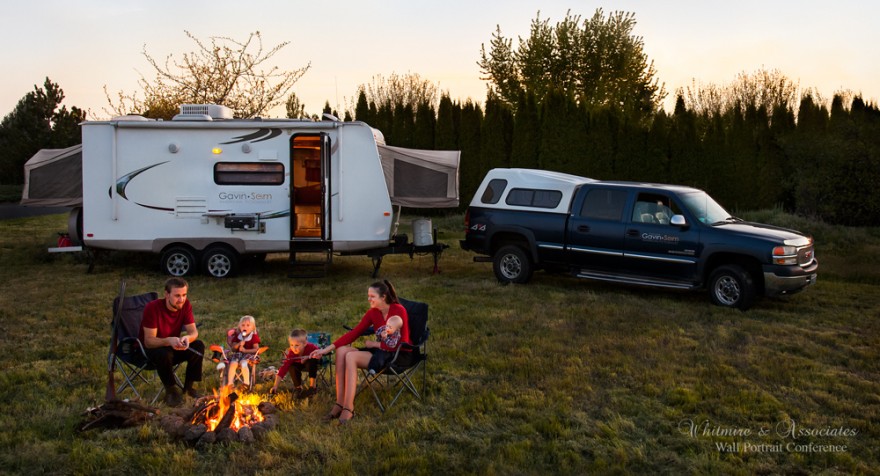
By Gavin Seim: Follow updates on… Facebook | Twitter | Newsletter
There’s nothing like miles of open road and your beautiful wife riding shotgun. Like giggling kids in the back seat with camera bags and cracker crumbs. Like the warm wind that whips in the window and tosses your hair. There’s nothing like the feeling of adventure and uncertainly. Of going somewhere you’ve never been before, tasting nature on the air, and doing something that, just maybe, no one else has ever done before…
A photographer and family road tripping across the USA? No easy task, but it teaches you a lot. About versatility, family, and of course, photography. In fact, many of my most advanced techniques and studies come from the zero deadline environment of road tripping.
In 2011, we spent around 3 months on the road. In 2012, we’re spending nearly that just for our Winter tour and probably 4-5 months in total. To be clear, we’re not just heading to snowbird hideaways and hunkering down. We travel, thousands upon thousands of miles, exploring the US and all it has to offer an American Pictorialist seeking the very best views in the world.
How It Works:
The long trips start months in advance: planning the direction of travel, lining up workshops or events to help pay the hefty gas bill. We’ll be up around three thousand dollars just for fuel for our Winter tour. That part can be a real burden, and it really makes you think about what’s happened to costs and the economy in this country. But let’s not get into that just now; I’m having fun here.
Next, I work like crazy around the studio in preparation. That also involves making sure sessions are scheduled for our return or out the door before we leave. I run a low volume studio that focuses on high end wall portraits, so I can be flexible regarding when and how I organize sessions, but it still takes planning. I don’t want to lose too much business. I make sure the house is sewn up, too, and try to leave things tidy. We make sure the maintenance and latest upgrades are done on the Super Camper. Back at the studio, I tie up all the loose ends, put out a sign that says, back in three months, turn ON the print spotlights, and lock the doors.
Here’s an inside look at The Super Camper. A few upgrades have been added since this, but you’ll get the idea.
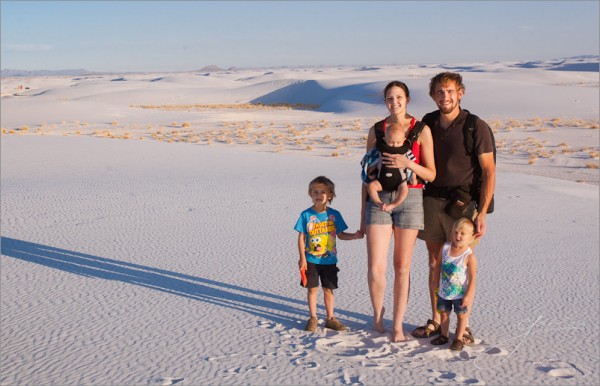
Time To Roll: The wife and I load up everything we can fit, including the our three kids, and off we go To The Wild. The main thing that gets us out there is the Super Camper. It’s a 2011 Forest River 21SS that’s been tricked out as a boondocking machine. Still, It cost $20,000 brand new and we’ve probably only put another 5k into it. It’s pulled with our 2001 GMC 2500 Crew Cab 4×4 running a Duramax diesel. For those interested, this little trailer and all the upgrades we’ve installed run up to about $25k. No chump change, but not so much considering what we can do with it.
But the chaos and excitement does not end there. We rarely visit a paid campground of any kind. Yes, in part that’s due to the conservative nature lover in me that says one should not pay to camp in the wild. The other part is the fact that spending $15-50 a night for a campground adds up fast. The third is that avoiding the more developed sites allows us to see far more amazing things. If I wanted to sit in a gravel lot next to sixty huge motor homes and call it camping, I could just stay home. We only pay to camp when there’s no other option. And sometimes we get pretty bold, just pulling off the road and setting up shop.
No hookups, no problem. The Super Camper is boondocks ready, and with its small size and good ground clearance, I can take it places that would scare your pants off. And ours, too. Frankly, I’m so used to NOT hooking up, that if I have hookups it hardly feels like I’m camping. That’s just me.
As you’ll see in the video tour, we’re compact yet self sustaining. We’ve got solar, extra batteries, and a little generator when things get low. Combine that with some water mods and good organization, an extra hauling rack, and the truck itself, and we’re ready for the wilderness. The tanks and lines are even winter ready, and we can turn on heating pads if things get nasty. We can load everything up and make it four five days without even going shopping.
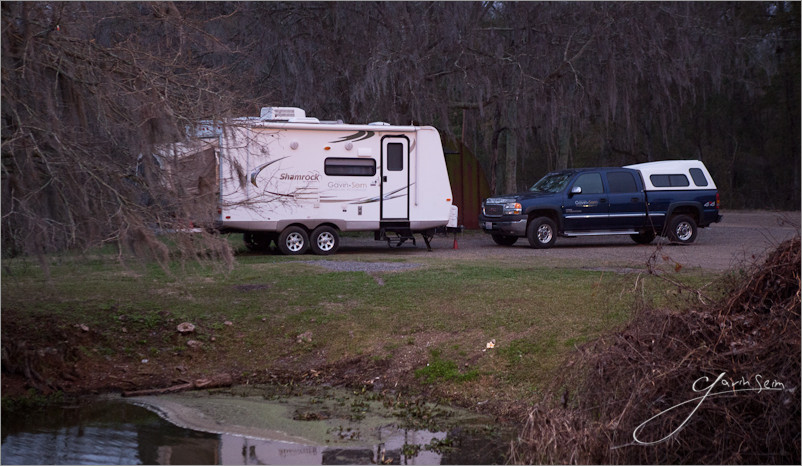
On The Move:
So it’s Sondra and I, three kids and thousands of miles, as we travel the US for workshops, pictorials and adventure. Let’s look at the typical day. Something that usually starts with us sleeping in, except, of course, the days when I go out to work the sunrise.
By the time we get up, dress the kids, have breakfast, make espresso (very important), and load up, it’s often time for lunch. So often we make a sandwich and then hit the road. Sometimes with trailer in tow, sometimes just us and the road, as we roam and explore potential locations for me to work in. Sometimes we it up the local tourist attractions and, of course, playgrounds for the kids. We rarely stay in one area longer than a week, and when we find a new camp, we can be fully setup in about 15 minutes.
And did I mention we love coffee? We grind it fresh every morning in out little camper, and while on the road, we seek out roasting companies which we then go visit, interview, buy coffee from, and blog about. The coffee site I run is called Epic Bean.
I learn a lot from these. And I mean a real lot. It’s during these trips that I refine and experiment photographically. Finding new places and sights is part of it, but I can just stand in a field for hours and try things, analyzing myself and other techniques that the industry uses. It’s often a science adventure as much as an artistic and a family one, and brainstorms come often.
Each day also brings work. I have to keep up with Seim Effects projects and customer service. I always have new blog entries and articles going, and, of course, there’s the fiction writing I do with my brother Nathan. That does not stop either. I have to take time each day for specific work tasks like email, maintaining FB pages, and the like.
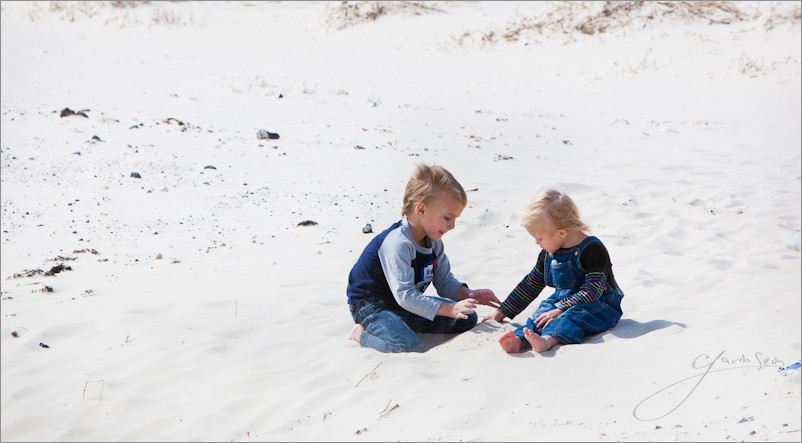
Not All Gravy:
Yes. There’s stress, yelling kids, too many potty stops, things breaking on the camper, propane bottles running out in the middle of the night, storms, bad roads, and plenty of other things. Some days we think we should just go home and take a vacation from vacationing. Then we come to our senses, look back on the memories and images, and think, wow, this is a real blessing.
Sondra is great and helps make all this happen. I don’t think most women would be able to handle it. But then, warm weather in the middle of winter is a strong draw for a women. And it’s harder to go crazy when you already are, so we’re both good there. 😉
People say they don’t have time for road trips. OK, maybe not everyone can travel as much as we get to. But don’t let it stop you. Make the time to get out. Even for a day or two, or a week at a time. Just roam out in the wild. I put it off when we started having kids, pouting mentally that we were tied down and the goals of world travel were infringed upon. Then I changed my own bad attitude and jumped in. I realized that there are endless things to see right here, within reach of your wheels. There’s nothing like a road trip, not for your photography and not for your family.
You can view the map of where we’ve been here, along with notes on camps, coordinates, the works. We’re not stingy. And, of course, you can stay tuned to this blog and the FB Page for updates from our travels. You can also visit the tours page for a list of up-coming travels. This is already long, but I’ll be back to update it as I find more to say.
[xyz-ihs snippet=”newsletter”]
Details and Extra Tips – Am ongoing resource for those who love adventure and camping:
So how do we stay connected, sane, and nearly always find free places to camp? A lot of ways. Here’s what we use and some things we’ve learned.
When on the road for a new destination, Sondra is charged with research while I drive. We use a Verizon MiFi along with our iPhones and laptops to keep us connected nearly all the time. Sometimes only ATT has service, sometimes Verizon. It’s good to have both. That part may not sound very camping-ish, but the main reason we can actually do all this is because I can manage writing and Seim Effects tools from the road. Staying connected is paramount, and it’s what allows me to write journal entries like this from thousands of feet up in the hills.
Boondocking in remote areas with no facilities is not the only way, but it’s king if you want to find great places. We’ve learned that sometimes you need a bit of Gypsy boldness to do this. Not that we’re looking to trespass or get in trouble, but laws vary from state to state and even on a per city basis. We try to research the area to which we’re going. Sometimes when we’re making miles, we just pull off on a side road and set up camp. We rarely cave to the “lets just pay for an RV park because we don’t know what to do.” It feels good to be bold sometimes.
As for traveling with three kids aged 5 months to 4 years, the main thing is you can’t be all business. They’re away from family, cousins, and friends, too. We frequently go to playgrounds and take time to get out and have fun. Sometimes the kids get cranky, but overall they seem to love the fun, snacks, iPods, hikes, grilling, and adventure.
Essential Resources We Use:
Using the MiFi on the road, we often pull out the laptops for finding locations. We browse the Days End directory, a giant list of user submitted boondocking and free (or nearly so) camp spots all over the US. It’s something you can get for a small fee if you’re a member of Escapees RV Club. Our Garmin GPS is also one of our essentials. Along with iPhones, apps and web pages that I’ll more below.
Google Maps are invaluable. Looking at them we can find National Forests and other parks, sometimes browsing using satellite views of the landscape. We get some amazing spots using that method, as you can find remote areas, then look for signs where people have set up camps in the past. Tire tracks, pullouts etc, fire rings etc. It’s a practiced skill.
Here other tools use to make it happen…
- Our Travel Maps. The places we camped our scouted in the past. It getting big. See below for how to make them.
- Gas Buddy. Saves us a lot of $$ by showing us the best fuel prices.
- Location allows us to find coordinates overplayed on the map so we can route or send ourselves coordinates for later use.
- All Stays camp and RV is really helpful for finding services and campgrounds when we need them.
- Cabelas Recon Hunt. An iPhone app with lots of tools but mainly a map that you can overlay western states public land boundaries on a Google map for a small fee per year. Good to have also as when you have data you can quickly load a G map with relevant info.
- AccuTerra is a mobile map system that allows you to download map grids for offline use and show public land boundaries like BLM etc. This covers all states, but you do have to download each sector (from the phone) to use.
- boondocking.org. A free website database of boondocking locations based on coordinates.
- freecampgrounds.com. A website with free or cheap camp spots. We don’t use it as much but it’s another recourse.
- SAS survival guide is a learning tool available as a book or a mobile app. It has information on nearly every emergency you might encounter. Learn survival basics.
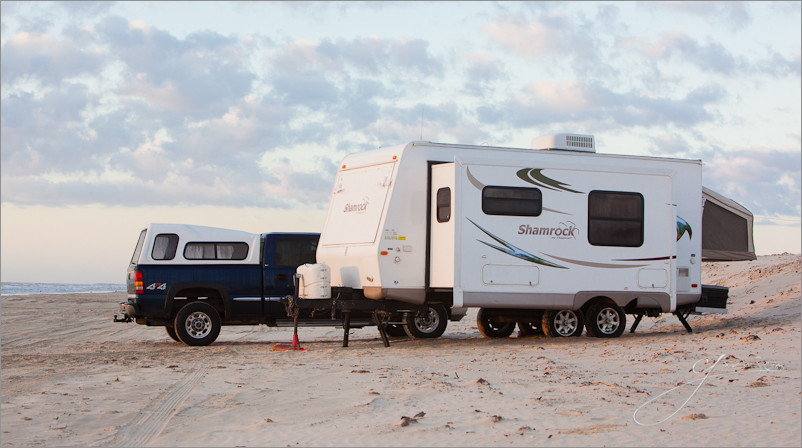
On the note of finding great camping. When on the move, we sometimes just use parking lots, truck stops, WalMarts, and the like. But once we arrive, that changes. National Forests are generally open areas where you can creep deep down remote roads and camp for free. NF people are “usually” helpful, rather than looking to get you in trouble for breaking some rule (read, State Parks). National Parks are sadly not so open to camping, but we visit a lot of them, so usually we look for a open area nearby, such as a bordering forest or nearby BLM/government owned land that’s not posted. OHV areas often provide open useable space as well.
Just be careful. In remote areas, old dirt roads can go from bad to worse very quickly. And when towing a trailer, turning around is not always easy. Oh yeah, we’ve been in some scary situations. One time, it was so bad I made the family get out, and I drove down a muddy hill with the door open, ready to leap out. I really thought the car might slide off the slick mud and right over the edge. Memories… Sometimes we’ll find a flat spot to drop the trailer and then scout further up into the hills so we don’t get into a “situation.” Other times we just dive in, saying a prayer and watching out for sheer cliffs and soft sand.
Of course we also load up on audiobooks for the long drives. It makes us look forward to travel. And then there are Sundays where we try to slow a bit and try to make sure we have cell reception so we can phone into the conference line of our family bible study, staying strong in things that really matter.
Of course in the camper we carry a plethora of resources, like extra food stores, extra water, lots of first aid stuff, chargers, batteries, toy bins for the kids and more. We cram it in.
Our Tools and Gadgets:
Before we look at major camper upgrades, there’s lots of smaller things we’ve found to carry along that make thing go smoothly. Here’s our favorites.
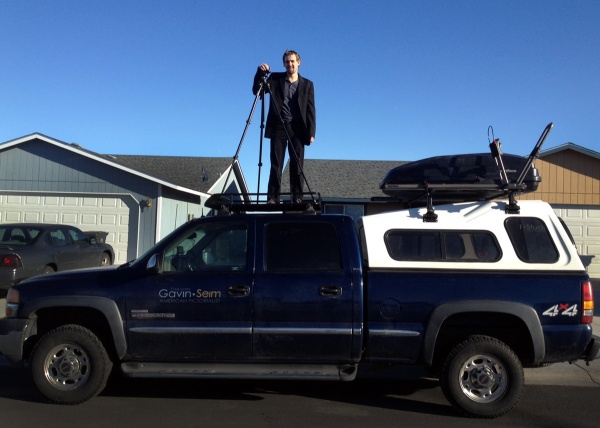
First Aid: Carry a good kit. I like this big one in the camper and then carry smaller ones like this in my day pack and the truck. Then update the kits with some Celox or Quick Clot for more major Trauma in the field. Also carry an Extractor of these for snake bites and Water Gel creme for burns.
Radios: If you don’t have Ham radio, get a pair of FRS units. They won’t offer as much range as they say in the hills, but they give some form of communication when people are apart. We also have a Ham Radio system in the camper as well as in the pack.
Flashlights: I prefer super bright LED lights that using 18650 laptop cells and a simple charger. For a small light this X2000 is great. Cheap and really bright for the size. Way more so than your average Mag light. I also like to catty a few insanely bright lights. For that, get P7 series LED light like this TrustFire, or something even more bright like this. Either of these is probably the brightest flashlight you have ever seen. If you buy this bright of light in stores you’ll probably pay 4x more.
A dash mount GPS is a great tool. Yes our smartphones have maps, but having a dedicated unit that needs no cell connection for basic road mapping is a huge time saver.
Bear Spray and guns. People make jokes about me carrying this but it’s no joke. When in the wilderness you can run into a wild animal or a wild person. One of these huge can’s of pepper spray resides in the camper, the truck and my hiking belt at all times. We also have guns, but laws differ from state to state and Bear spray is a way to always have something.
An Inverter. Converting power from your 12V battery system to run regular AC things like laptops and battery chargers is invaluable.Get a decent inverted and mount it somewhere easy access. It will keep you from running the generator so much, or once you add solar will keep with with AZ power nearly all the time. You wont be running AC on this but it will keep you going.
A Generator. A quality quiet generator is not cheap, but it’s also one of the kings of the boondocker system. Generally I’d recommend one like a Yamaha 2000. It won’t run your AC, but it’s fairly small, will charge your system and keep you rolling without waking the dead. If you get a great solar system on the roof (250-400watts) you won’t need it much, but it’s still a valuable backup. You can of course get a larger one that powers heat, AC and the like if size and eight are not an issue.
Laundry Bags. Not real exciting, but laundry will build up if you’re traveling more than a few days. You’ll want a place to stow it and these help keep it tidy and easy to take to the laundromat.
Metal detector. You want things to do on the down time and this is a fun one. This Garrett Ace is probably the best bang for the buck. A decent detector for a decent price that is pretty compact.
Weather Station. Knowing what the temp is and what’s coming up is very useful. You don’t need to get crazy, but this is a nice little wireless station for a great price.
If you want to get serious about your tools this cordless reciprocating saw is amazing for cutting away branched and general work around camp. Want something a little more simple. Get a pocket chain saw like this. It works well.
We have solar on the camper, but this little 10 watt panel and a compact reserve battery is great for hiking and can charge your phones and the like.
This Gerber folding shovel is rock solid and small. Don’t bother with the cheap ones. Also for a hatchet, get the Estwing. It’s the best in class.
If you need your coffee check out the Bialetti stove top espresso machine. This thing makes a legit cup of actual pressurized espresso over a stove or fire. If you prefer a smooth drip cup check out the Hario Dripper.
These 25ft jumper cables are good for some extra power reach. A backup battery is also a good idea. That or a battery charger that you can run from your generator.
Reserve water is critical for the adventurer. You can get functional 5 gallon water cans at a place like WalMart. But we’ve switched to these military spec water cans. You could run these over with a truck. Never a leak.
Don’t forget a good hunting knife for your hiking pack. Also keep 100ft of paracord on hand. It can come in handy for many things. I keep on in the camper and in the pack.
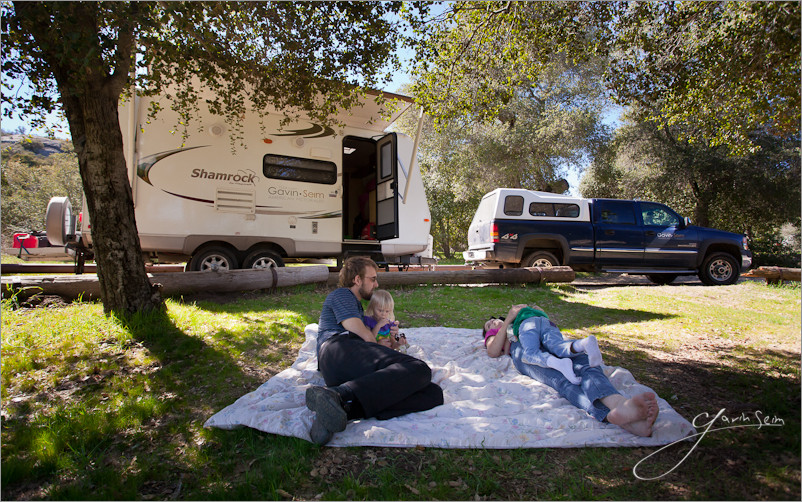
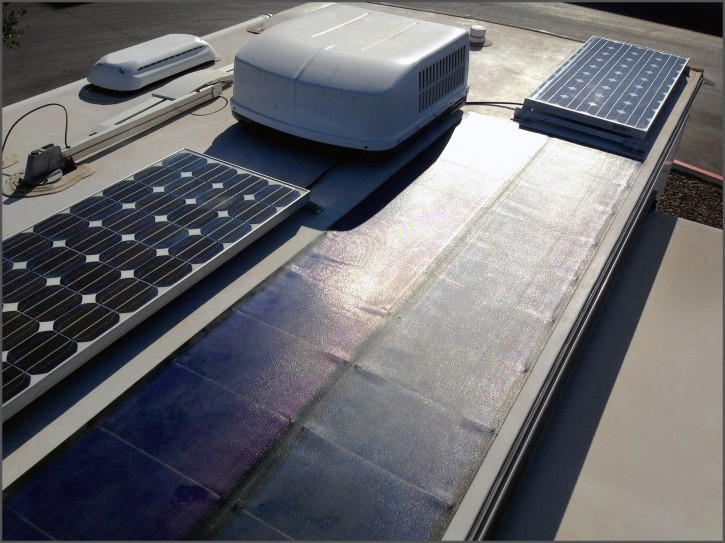
Camper Power System: We have to keep everything charges and running. Even in remote areas. Solar takes care of most our power needs. We have two UniSolar PVL 68 flexible panels. These stick directly on the roof giving a total of around 136 watts in full sun and perform better than traditional panels in shade.
Next we added traditional silicon glass solar panels that put out around 140 watts combined. This bring us up to a total solar infrastructure of about 275 watts or 15 amps of charge power in full direct sunlight.
These are 12V panels running in series, which means about 24+ volts are going down the cable and into a Sun Saver TrackStar MPPT charge controller, which then converts it to the 14’ish charge volts for the batteries.
We have 4 batteries mounted in two locking boxes on the front. The unit came with just one. Having more has been great and the extra power is invaluable. On a full charge we can fully run the house for days even in bad solar weather with our Trojan T105 golf cart style batteries. We have a total for about 450 amp hours of 12v power.
We use power pretty heavily with computers, heater fans and the like. In fair whether and sunshine the solar pretty much keeps us ahead indefinitely. Depending on sunlight and weather, we still have to run the generator occasionally. More so if it’s sub freezing and we have to power tank heaters.
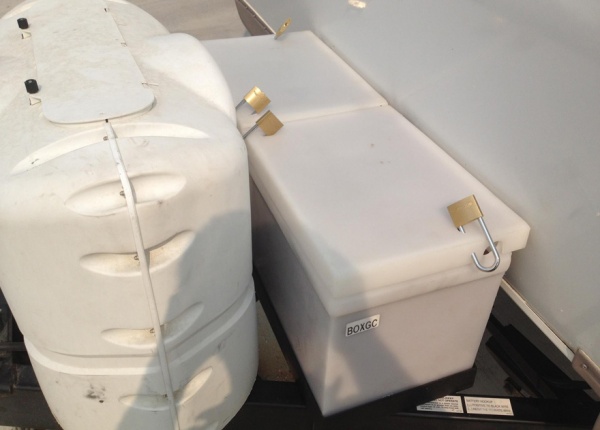
Not counting solar we can get a total of about 450 amp hours with 4 T105 batteries. That means with batteries at full capacity we should be able to pull a 10 amp load or 45 hours straight. To give an example. A 13 watt light bulb in the RV would be using about 1 amp. So 10 of those running for 45 hours straight would drain us. If we didn’t have solar.
Our generator is a Honda EU1000. These are inverter based generators and extremely quiet. They rarely disturb anyone. We plan to get a 2000 soon (Honda or Yamaha), as the 1000 is a little small for this rig and charging batteries fast.
Under the from Cabinet we have a Cobra 1500 watt inverter. This will power AC things like computers and coffee machines from the batteries without running the generator. The Cobra is not the best inverter and in time we may upgrade it, but it works pretty well.
We have this inverter wired into the main power system, so even in the boondocks all the plugs work. A wire runs from the inverter to the main power box, but before it gets there we have this 30 amp AC switch that selects either shore power or inverter power. This prevents any accidents and allows the entire rig to have live power while boondocking.
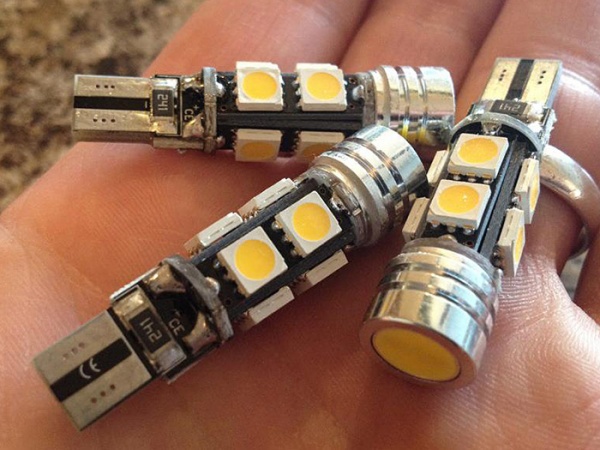
LED Lighting: One way we conserve power for other things is by using LED lights. They use about 1/4 less power to produce the same amount of light. This means we can have plenty of light without having to worry about power.
We started by buying a few LED’s at RV supply stores. But they go at a premium. $10-30 for one light. That adds up when you have 20+ bulbs throughout. Then I did my homework. I wound the same type of LED lights on eBay for just a dollar or two each. Loads of lights in every base you need as a fraction of the cost. You just have to wait a bit longer for shipping as they often come direct from China.
Out camper uses mostly the T10 series lights in the photo. Here’s some of them on eBay. The 1141/1156 are also common. Search for them here. But look around. Whatever base style you need you can probably find them. They work great, use less power and are if you shop. I prefer the warm tone styles (around 3000K) as they are closer to traditional lights. But of you like the cooler look there’s plenty in that style as well.
Speaking of LED. There’s 8 perimeter lights mounted on the roof. We used these 10 watt LED floods and they light up the whole area. This is a very nice upgrade. I’ll add a photo in the extras.

Other Upgrades:
We have a silver blanket that goes on the tent bed for colder or hot situations. It really helps hold in (or out) the heat, by reflecting. You can make your own, but we use a one called a Popup Gizmo. They also help keep condensation down, something that’s a common issue in tent style bunks.
We use heat pads on the holding tanks and lines. Like these. I installed these with inside a switches and turning them on keeps tanks from freezing. These are 12V, but would drain batteries pretty fast if it was really cold. Extra generator time would certainly be needed.
The rack on the trailer was also an upgrade. We had a hitch installed and then got a 60in aluminum rack for it. It’s rated for 500lbs. We attach the storage bins and battery boxes with bolts. They’re very secure, which is important when going up rough mountain roads.
Our Espresso machine is a Bialetti stove top model. It’s nothing like the Giotto Rocket at home, but it makes a good cup on the road. We also have some manual drip coffee tools and we grind fresh using this drill modded hand grinder.
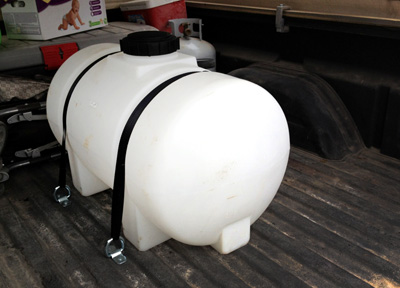
Our projector system uses an Optima PK301 pocket LED projector. This is no ultra bight, but on movie night or in need of a little presentation we can get a nice looking 50 inch image on our pull down screen that we can hang from the ceiling using 3m Command hooks we’ve installed.
We made a Velcro cover for the skylight in the bathroom so I can go in at night, block out all light and load my 4×5 film.
I keep two extra water cans in the truck or shower when we travel. When stopped, we can pull these out and suck the water into the holding tank using the mod described in the video. This allows us to maintain fresh water without loading up the trailer and driving to water. Recently we’ve also mounted a 35gallon fresh water tank in the pickup. We full this and it gives us another full tank of water. We can now go for a week or so with normal water use.
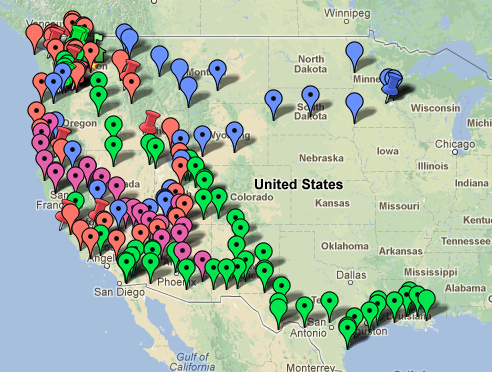
The MAPS: This is our main travel map. They are very important as they show us where we’ve been, where we need to go back and what we’ve done. It’s a notebook of our travels really. I have a workflow for the maps. I save them all to a Google My Map with color pins of various types to represent the year etc.
When I find or camp in a good spot I use an app the grabs my current coordinates like Right Here of GPS Location mentioned in the app list above. I then email myself those coordinates with a couple notes. The nice thing about this is that even if you don’t have a connection it will just draft the message and I’ll get later.
When I’m settled with internet I open the coordinates in Google Maps and save the spot as a pin to a My Map Google maps in My Places. See here.
Now and then I export and backup the My Map as a standard KML format file if case it ever gets nuked or I decide to use another app.
I think that covers it, but I’ll update this as we update our rig and learn more. If you have questions let me know. I love talking about camper tech. Hope you enjoyed… Gav
EXTRA Photos: Because I’m running out of room.


Sounds like you’re out here living the dream! Nice of you to share your good ‘docking spots, too. I’ve been gathering some resources, as well; they’re here in case they’re useful to you.
Do you find that the paper guide from Escapees is still superior to online sources of info? I haven’t found one website with ALL the available boondocking, but we’ve found a lot of great places by checking several sites.
Thanks I’ll check it out. The more spots the merrier.
As for Escapees. Their paper guide to campgrounds is OK. But the Days End list is like nothing else. You can download the latest PDF and simply search a city or area you’re going to, to see what people have submitted in that area. The DaysEnd directory is far and away the most complete single source in one place that’s we’ve found. But we still use the other that I linked in this post.
Gav
Wow -three little kids on a road trip! I’m impressed! We did it years ago but we just had one kid.
I’m a map junky so I’ll be stealing some of your boondocking spots. Thanks for the information.
Your photography is beautiful!
Hey Karen, thanks on all counts. It’s been work, but totally amazing.
The wild and dispersed websites are great sources. Thanks for the reviews. Jo Ann and I are planning a 3 to 4 month round the south west trip for 2013 and I am busy googling and sending for every bit of information from city county and state visitor centers. Much of that is aimed at comercial activities but I just cut and paste our own guide books. I did this for a 3 month backpacking trip to England in two College composition books although we did spend 3 weeks in a London Youth Hostel before journing out on the various bus routes. I am looking at a Jeep waggon for this trip backpacking with wheels and since we do a lot of hiking this will get us into those BLM Backroads (Four Wheel Drive Recomended) areas of Arizona and Utah. I have purchased the benchmark Road and Recreation Atlas for each state as a starting point but am collecting specifics into a 3 ring binder. Reciently retired the Golden pass will get us into most Federal lands and a discount for some State Parks. Like you I look for nearby National Forrests or Bureau of Land Management areas where unless restricted Dispersed camping is allowed with a few rules usually distance from the road or what passes for one. I have found most National forest roads to be in good to usable condition as they are maintained for use in case of fire emergency.
While we will not have the Gear that you carry I left the darkroom behind in 2006 and am now 100% digital but will probably pack a Nikon and several rolls of Velvia 50 just in case. My digital camera charger smoked in London and a replacement would have run too much ( Wait 3 weeks for a replacement or pay double to get one removed from an in stock camera). Fortunatley although I was doing Digital I still did not trust it completely so had a Nikkormat and 2 lenses just in case so I shot 70 rolls of color slide film and mailed the digital camera home. We will carry a laptop but do not have wireless internet I intended to find hot spots every few days and do my on line searching from them as needed Libraries are often set up for this nice tables and air conditioning as well as local guide books to look at and snap photos of interesting pages or usually have computer stations available also many fast food spots also have wi-fi so sip a soda and surf. I am ordering Bear Spray this week as well as a LED Lenser and camplights from Dorcy Rechargable batteries and a few other get ready items. For a camera I am looking at the Sony Nex series and adding the 16 mm lens, my wife used the Sony point and shoot and I liked the low light and close focus of her camera she now uses a Nec super zoom which would be the wildlife camera.
Great advice and are you planning or do you have a log for the trips with more specifics on locations and activities.
Bill Lewis
Good input Bill. Sounds like you have a great tips planned. I’m also a big fan of boondocking on Federal lands, as I’m sure you gathered from my post.
I do have a tentative list of my coming tips on my tours page… http://f164.com/tours. And don’t forget to take a peek at the maps page where I share the places we’ve been… http://f164.com/tours/
Gav
I think finding your site was a small gift from God. 🙂 We have been dreaming and scheming for the last year of how we can live on the road. Do we buy an RV? Do we use a camper? Do we just take off in our mini van and find cheap hotels? So much so that I despair of ever getting our chance to leave. I LOVE that you are doing this. So many people think we are crazy to want to take off with our 3 kids (7,5,2), homeschool, and just GO. Thanks so much for your resources. I’m excited to put them to use!!
Thanks Jess. Perhaps to you for homeschooling your kids. I was home schooled and my kids will be as well.
It’s truly amazing to take your family on the road. I glad this helped. Don’t hesitate to get in touch if you have questions. I love talking about our adventures.
Gav
Hi Gavin – my husband and I bought a 36′ motorhome and did something similar the winter of 09-10. We wanted to do it again but plans changed. I’d love to see the inside of your custom trailer but the video cuts off after 51 seconds.
Super. Nothing like the open road.
Odd about the video. YT does that sometimes. Try the direct link… http://www.youtube.com/watch?feature=player_embedded&v=VsiWiNTHvGY
I’m also working on a new video. We’ve done a good deal of upgrades since this was made.
Gav